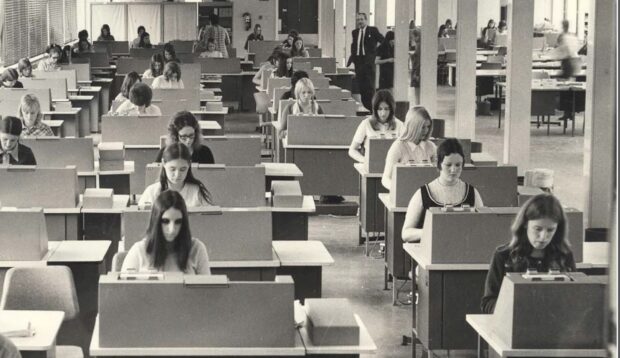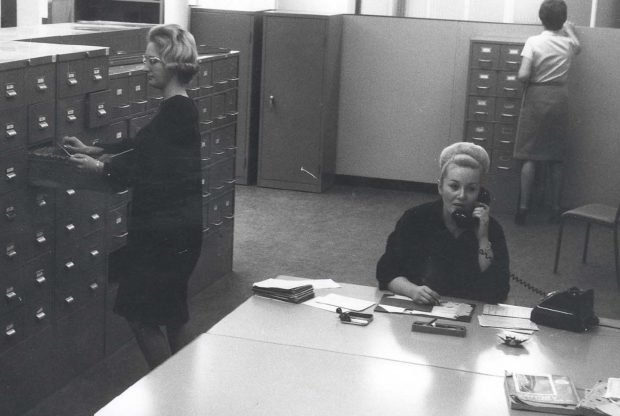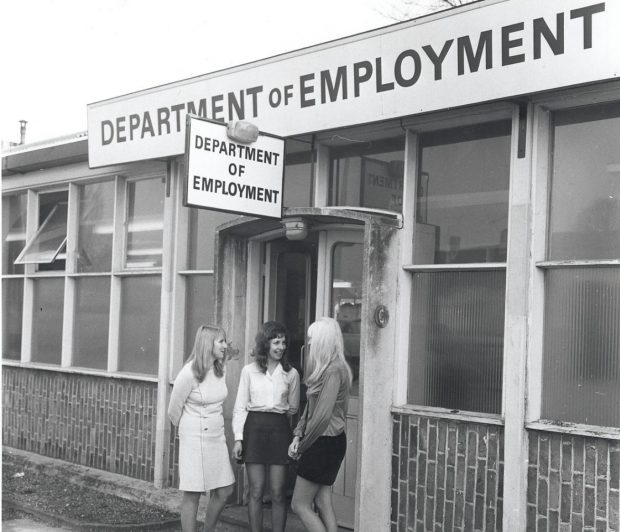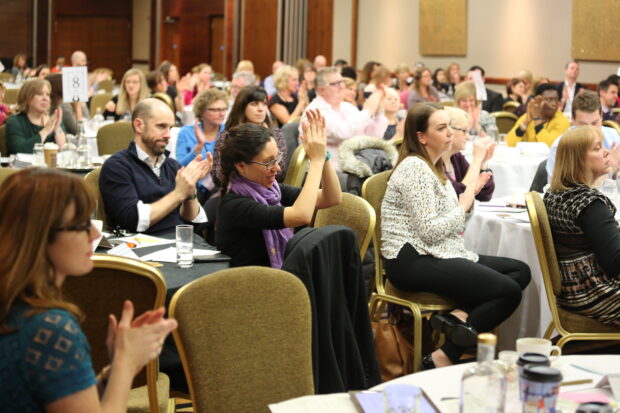I’m Angie Tailby, an Archivist in the DWP Research Library, DWP Digital. I’ve been looking through the archives in celebration of the centenary of the women’s suffrage movement.

I’ve taken a brief look at the types of jobs women have done in DWP and the Civil Service in the past 100 years and how times have changed in those 100 years since women first got the vote. We’re also approaching International Women’s Day, the theme this year is ‘press for progress’. So, it’s been fascinating to see how we have progressed through history, get an insight into how the role of women’s work has changed and the progress that has been made.
First women in work
The first women to be employed as civil servants happened as far back as 1870 when the Post Office decided to employ a number of female clerical workers. They were paid 14 shillings a week; considerably less than their male counterparts. There was uproar from the male clerks who complained about the “grievous dangers, moral and unofficial, which are likely to follow the adoption of so extraordinary a course”, but the ceiling had been broken.
By 1880 the advancement of modern technology ensured that women were employed to use the new typewriter machines. In 1910 the first Labour Exchanges were opened and women clerks were needed to manage the women’s section. The work was by nature routine: filing, indexing, collecting statistics, drawing up reports, interviewing employers and employees. The women in higher positions were expected to be educated and have initiative because sometimes they had to interview men!

There were no promotion prospects for women officers (unless the role was to supervise women) as the very first Civil Service Commissioner believed that “competition was bad for women” and that the whole idea of putting a woman up for promotion was “revolutionary”.
Not only were there very little promotion prospects, but up until 1946 women would have to resign on marriage. The ‘Marriage Bar’ of 1921 stated that “Women working in the Civil Service are not prevented from getting married but they are not retained in established capacities after marriage except with the consent of the head of their Department and of the Treasury.” So the message was clear – only un-married women or widows could work for the Civil Service.

Progress
Progress has been painfully slow. It took 10 years before the first women officer was allowed to keep her job after getting married, and that was only because she had risen up the ranks and her unique skill set was too valuable to lose.
By the late 1930s all duties were available to both genders at headquarters in the ‘Ministry of Labour’ - as DWP was then known. But in divisional offices and employment exchanges there continued to be a strict division of labour, and women were still barred from work that involved direct contact with male applicants.
After the Second World War the ‘Marriage Bar’ was lifted and segregation of roles also ended. However the majority of roles for women were still clerical – and although DWP was at the forefront of information technology in the 1960s and 70s, if there were any women involved in the big computer projects, their names have been lost from the archives. Women continued to be over-represented at the lower grades and under-represented at the higher grades.

Moving forward
But huge progress has been, and continues to be made. And, as the largest government employer of women, DWP is committed to bringing about real change. We have a specific gender lead, Ozma Iqbal who supports Mayank Prakash, our Chief Digital and Information Officer and DWP’s Gender Champion, on all things gender-related.
In DWP Digital we are committed to redressing the gender balance. For example, our Women in Technology group is working hard to increase female representation of technical subject matter experts.
And, in the Civil Service we have family friendly policies that appeal to women, such as flexible working hours and job shares.

Supported by some forward-thinking managers, the early female civil servants had an opportunity to influence the change in society that the suffrage movement fought for, and for which future generations of women have been able to build on. Women may have had to leave work when they married, but if they chose to stay then they were able to carve out successful careers for themselves. The first woman Permanent Secretary was appointed in 1955 and even though there has only been a handful since then the opportunity is there for advancement and promotion from whichever department you start your Civil Service career in.
DWP Digital is currently recruiting technology specialists. To find out more visit our DWP Digital Careers website and have a look at our LinkedIn page. You can also subscribe to this blog and following us on Twitter @DWPDigital and @DWPDigitalJobs.

13 comments
Comment by Melanie Harris posted on
Really interesting blog Angie!
Comment by Andria posted on
Love it Angie!
Comment by Andrea Milns posted on
Really interesting article and nice photos. Andrea
Comment by Ian Evans posted on
This is fascinating, thanks for sharing!
Comment by Katie Cawthorne posted on
Very interesting read Angie - how times have changed!
Comment by Sheetal Kaur posted on
Very interesting article. Well done!!
Comment by Tom Keaton posted on
This is a fascinating article. I had no idea married women had to leave the Civil Service well into the 20th century. It feels so archaic. Thank goodness things have and continue to change.
Comment by Pete Rooke posted on
Very enlightening, lets hope many more glass ceilings get broken in the future, great article, Thank You.
Comment by Jared Hetherington posted on
Very interesting article - I didn't know about the marriage bar or the ban on promotion (and love the old pictures of the Department of Employment!)
Comment by Alison posted on
Great blog and great photos Angie!
Comment by Lindsey posted on
Interesting! How things have changed & thankfully for the better!
Comment by Sue Pirot posted on
Really interesting read! I joined DWP in 1978 and we were not allowed to wear trousers to work! ?However I have honestly never felt any inequality in my work and was positively encouraged to progress. The behaviours of my early male managers however left a lot to be desired but that is a whole other story!
Comment by Bobbie Scott posted on
Loved this article and the photo's, keep up the good work